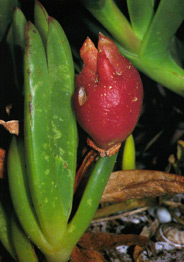|
EYRE'S
JOURNEY ACROSS THE GREAT AUSTRALIAN BIGHT
Eyre's truly remarkable crossing of The Great Australian Bight and
the Nullarbor Plain is the feat for which he is best remembered. In
the full heat of summer and the depths of an Australian winter (1840-41),
Edward John Eyre explored the rugged and unforgiving coastline between
Streaky Bay on South Australia's west coast, and King George's Sound
- present day Albany - in Western Australia. In all a distance of
over 1200 miles.
An Auspicious Beginning
Eyre's
westward journey accross the Australian continent began at Streaky
Bay on 3 November 1841. With support and supplies from the sailing
cutter "Waterwitch", Eyre and his men literally hacked their way through
dense Mallee scrubland, heaving their axes from five in the morning
until ten at night.
Within three days Eyre's expedition had met
with a friendly group of aboriginal people at Smoky Bay. Led by an
amiable old man named Wilguldy, Eyre's expedition was blessed in being
able to rely on local aboriginal knowledge when digging for water
in sandhills. Eyre was particularly impressed with the ease with which
Wilguldy's people could live off the land, gathering food sources
such as snakes, lizards, goannas, bandicoots, wallabies and a variety
of native fruits.
|
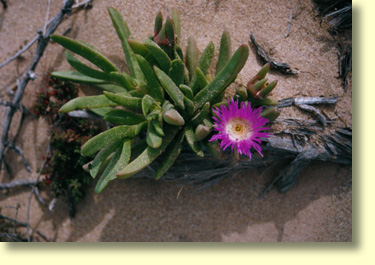
Pig Face plants and their
edible fruits
|
|
Ably led by Wilguldy, Eyre's
expedition made good progress and halted at Denial Bay where supplies
were offloaded from the cutter "Waterwitch' Throughout the journey,
Wilguldy's assistance was much appreciated and Eyre often rewarded
Wilguldy with the privilege of riding on horseback - an event that
never failed to impress Wilguldy's tribesmen!
By 17 November 1840 Eyre's expedition had
reached Fowlers Bay - the next staging point in their crossing of
the Nullarbor Plain and the Great Australian Bight. Fowlers Bay again
saw the good ship "Waterwitch" replenish Eyre's expedition with supplies.
Eyre Discovers Water At Yeer Kumban Kauwe
During the next two months Eyre made three
attempts to round the Head of Bight. Water was always in critically
short supply - particularly so on his second failed attempt when Eyre
was clearly distressed to lose three of his best draught horses to
exhaustion, thirst and the blistering Australian summer sun. After
the second failed attempt to reach the Head of Bight Eyre realised
that travelling with drays was impossible in such desolate country.
There were just too many sandhills, and where there weren't sandhills,
the scrub was too thick to make for rapid travelling.
On his third attempt Eyre wisely resorted
to a packhorse and finally reached the Head of Bight on 7 January
1841. Whilst camped at the Head of Bight friendly aborigines again
showed Eyre a number of native waterholes located in a vast system
of huge white sandhills. In Eyre's own words "... we were indebted
solely to the good nature and kindness of these children of the wilds
for watering our horses: unsolicited they offered us aid, without
which we never could have accomplished our purpose."
In the local aboriginal language these
waterholes were called Yeer Kumban Kauwe. Today, 160 years later,
these amazingly beautiful sandhills can still be seen from the vantage
point of the whale watching platform at the Head of Bight; and although
the sandhills may have drifted, there's no doubt fresh water can still
be found there.
To the west of Yeer Kumban Kauwe Eyre could
see the enormous cliffs of the Great Australian Bight. Today we know
them as the Bunda Cliffs. Eyre resolved to explore the area in the
hope of pioneering an overland stock route to Western Australia. Eyre
made a round trip along the cliffs for a distance of forty five miles.
On 11 January Eyre headed back to his support depot in Fowlers Bay
- a distance of 130 miles or more by horse.
Fireworks At Fowler's Bay and Unexpected Delays
Eyre and his party camped at their Fowlers
Bay depot until the last week of February and on the evening of the
23rd Eyre treated Fowlers Bay to its very first fireworks display!
As Eyre himself wrote "... on the afternoon of the 24th I intended
finally to evacuate the depot, to amuse my natives, I had all the
rockets and blue lights we had fired off."
The departure of Eyre's expedition was
delayed a day however, with the unexpected arrival of the cutter "Hero".
On board the "Hero" was Mr. Germain, a friend who earnestly advised
Eyre against crossing the Great Australian Bight. Eyre also received
letters from Governor Gawler and colonists in Adelaide begging him
not to undertake such a perilous expedition - especially given that
Eyre would be unable to rely on ship supplies farther west than Fowlers
Bay.
The next day, 25 February 1841, Eyre continued
his journey westwards to King George's Sound - still over 1000 miles
away. Accompanying Eyre was his trusted friend, John Baxter, and teenage
aboriginal boys Wylie, Joey and Yarry. Transport for the party consisted
of 9 horses, a Timor Pony and one foal. Food supplies were calculated
at an allowance of six pounds of flour per person per week - approximately
240 pounds of flour per person..
By 2 March Eyre's expedition had travelled
over 120 miles and finally reached the Yeer Kumban Kauwe sandhills
- a place where they knew water could be found by digging wells. Despite
the constant torment of sand, wind, and the painful stings of large
horse flies, Eyre rested for six days before pressing on to the west,
beyond the Bunda Cliffs of the Great Australian Bight. From the accounts
of the local Mirning people, Eyre knew that the next waterholes were
well over 120 miles away to the west, beyond the Bunda Cliffs of the
Great Australian Bight.
Eyre Crosses The Waterless Bunda Cliffs
On the 7th March Eyre's expedition again
headed west, travelling both by day and night through the Nullarbor
Desert. Travelling at a desperate pace of 25 miles per day both man
and beast endured great suffering. Eyre's exhaustion was evident as
he sometimes dozed off to sleep even as he walked. For 4 days Eyre's
expedition battled their way through salt bush and tea tree scrub,
trekking over the seemingly never ending limestone country to the
north of the Bunda Cliffs.
By March 10 Eyre had scouted ahead of
the main expedition party in the hope of discovering a break in the
Bunda Cliffs that lined their route, but none were to be seen. Eyre
was concerned for his pack horses which had been travelling for 4
days without any water whatsoever. The condition of Baxter and the
aboriginal boys was hardly any better - with all suffering parching
thirsts.
Despite the expeditions cruel lack of
water and the real prospect of death, remarkably Eyre still possessed
a romantic vision of the Australian wilderness. In his journal Eyre
was moved to write:
| "Distressing and fatal as
these cliffs might prove to us, there was a grandeur and sublimity
in their appearance that was most imposing, and which struck
me with admiration. Stretching out before us in unbroken line,
they presented the singular and romantic appearance of massy
battlements of masonry, supported by huge buttresses, and glittering
in the morning sun which had now risen upon them, and made the
scene beautiful even amidst the dangers and anxieties of our
situation." |
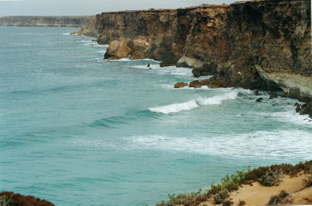
The Daunting Bunda Cliffs
A Brief Respite At Eucla
By
the morning of 11 March Eyre had passed the Bunda Cliffs. Eyre's
situation was still desperate however. During the previous night
Eyre had unwittingly trekked many miles past some sandhills - possibly
the very water bearing sandhills that the aborigines had mentioned
at Yeer Kumban Kauwe. Eyre took a desperate gamble and pressed on,
forlornly hoping to reach another set of sandhills he could see
in the distance. Today these sandhills can be found near the township
of Eucla, and they proved to be the expedition's salvation. Upon
turning into the sandhills Eyre was fortunate to strike the very
place where aborigines had dug little wells.
For a week Eyre and his expedition remained
at the Eucla sandhills. Much time was spent attending the horses,
and retrieving valuable stores that Baxter had been previously forced
to abandon many miles away to the east. The 18th March saw Eyre and
his party again heading west, but the horses were still in poor condition
and in need of water. Eyre ordered Baxter to drop the expedition's
stores and return to the Eucla sandhills, where the horses could rest
and later return with a good supply of water.
Difficulties With Making A Cup Of Tea on The Nullarbor
By March 26 Eyre's expedition was travelling
through dense scrub and over sandy ridges. Eyre realised that progress
was still unbearably slow and that the pack horses loads needed to
be lightened. Whilst the native boys were asleep, Baxter and Eyre
set about throwing away items that could be dispensed with. In all
a total of 200 pounds of items were discarded - including clothes,
buckets, water kegs, pack saddles, some firearms and a quantity of
ammunition.
In the days ahead the water situation
continued to weigh heavily on Eyre's mind. As water dwindled the aboriginal
boys showed Eyre how to obtain water from the roots of Eucalyptus
trees. Eyre was impressed to note that the quantity of water contained
in a good root would probably fill two thirds of a pint. His own boys,
as inexperienced as they were, even managed to obtain one third of
a pint in the space of 15 minutes.
By 29 March Eyre's expedition had consumed
their very last drop of water. The situation was now very grave and
required a desperate solution. Eyre's plan of action was carried out
the next morning when he observed that there was a heavy dew hanging
down from the grass and shrubs. With a sponge in hand Eyre dabbed
at the dew and squeezed water into a quart pot. The aboriginal boys
did likewise, gathering dew using a handful of grass instead of a
sponge. Altogether Eyre's party had gathered 2 quarts of water. In
the very best of British traditions Eyre's party then indulged in
the luxury of brewing up some tea in the remote Australian outback!
Eyre's Sandpatch and The Prospect of Starvation
Throughout the remainder of 29 March Eyre's party
plodded along until they reached some huge white sand drifts. In great
suspense members of the expedition frantically dug in the hope of
discovering water. Six feet down and seven days from the last wells,
Eyre's expedition had finally found another source of fresh water.
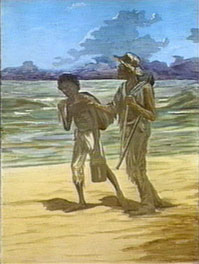
Today residents of the Nullarbor know the
area as Eyre's Sandpatch, a site located 50 kiometres southeast of
the present township of Cocklebiddy. As a site of historical significance
Eyre's Sandpatch is of considerable importance. In the past Eyre's
Sandpatch has been the site of a major repeater station for the telegraph
line linking the eastern states and Western Australia. The old telegraph
line was abandoned in 1927 however, and today the area is a major
Bird Observatory and site for a remote meteorological station
For 29 days Eyre based the expedition
at the "Sandpatch", hoping that his pack horses would regain some
of their lost strength. Attempts were also made to retrieve stores
that had been previously abandoned 47 miles to the east. Retrieving
these stores proved to be difficult, and much to to Eyre's regret,
one horse became blind and had to be abandoned, another perished from
sheer exhaustion.
By April the expedition's food supplies
were critically low and Eyre was forced to reduce meagre food rations
even further. Two plain meals of tea and damper per day proved insufficient
to sustain life however, and Eyre's party were forced to partially
live off the land - hunting for fish, sting rays and wallabies. Faced
with starvation Eyre's expedition even resorted to roasting bark from
the roots of young Eucalyptus trees. Imitating the local aborigines,
Eyre roasted the bark to a crisp, and then pounded it between two
rocks before chewing it. Eyre believed the roots were quite nutritious,
and according to his journal the roots ".. tasted rather sweet, somewhat
resembling the taste of malt."
By April 16 the food situation was as
desperate as ever, and Eyre ordered Baxter to butcher a horse that
was more dead than alive. For a few days horse meat provided the expedition
with its main source of food.
Seeds of Disunity
Throughout April seeds of disunity were
beginning to appear within the expedition. John Baxter, the loyal
overseer, was beginning to voice deep misgivings about continuing
the journey to King George's Sound - still over 600 miles away. For
Baxter, the expedition's best hope for survival lay in a swift retreat
to Fowlers Bay. Eyre clearly thought otherwise, believing that the
expedition had passed the point of no return.
The morale of the aboriginal boys was
no better, and on 22 April Eyre discovered that they had been pilfering
the expedition's meat rations. In response Eyre reduced the boy's
meat rations and there was a rebellion of sorts. Both Wylie and Joey
fled camp, probably believing that their best chance for survival
lay in striking out to the west on their own, and fending for themselves.
Events were to prove otherwise however,
and 5 days later Wylie and Joey returned to Eyre's Sandpatch in a
state of near starvation. Despite the poisoned atmosphere the boys
were welcomed back and they heartily ate an excellent stew - one made
from an eagle that Baxter had shot.
The Tragic Death of John Baxter
April 27 saw Eyre's expedition again heading
towards King George's sound. Eyre knew full well that the expedition
would need to make another desperate push through 150 miles of waterless
country. As the expedition headed west an abrupt line of cliffs met
their gaze. From naval charts Eyre knew these were the great cliffs
of the western escarpment, and they were just as threatening and imposing
as those he had seen hundreds of miles away to the east. To make further
progress Eyre's party resorted to walking along the immense clifftops,
passing through dwarf tea tree scrub broken by limestone outcrops.
On the evening of 29 April Eyre's expedition
camped for the night, hoping that a gale blowing from the southwest
would bring rain. Whilst Baxter and the boys were asleep, Eyre attended
to the packhorses which were grazing on patches of grass near camp.
At about 10-30 pm tragedy struck. As Eyre was returning to camp he
was startled to see a flash, one that was immediately followed by
the sound of a gunshot.
Near camp Eyre met an agitated Wylie who
cried out "Oh Massa, Oh Massa, come here." Upon reaching the campsite
Eyre was horror struck to see his loyal friend Baxter lying face down
covered in blood, in the last throes of death. Baxter never spoke
another word, and Eyre noted the 2 boys Yarry and Joey had fled, taking
with them 2 double barrelled shotguns. Baxter's death was definitely
a case of murder.
For Eyre, Baxter's death was a personal
tragedy and disaster of the greatest magnitude. The despair and anguish
Eyre felt is best described in his journal where he wrote:
| The frightful appalling truth now burst
upon me, that I was alone in the desert. He who had faithfully
served me for many years, who had followed my fortunes in adversity
and prosperity, who had accompanied me in all my wonderings,
and whose attachment to me had been his sole inducement to remain
with me in this last, and to him alas, fatal journey was no
more. For an instant, I was almost tempted to wish that it had
been my fate instead of his. The horrors of my situation glared
upon me in such startling reality, as for an instant to almost
paralyse my mind. At the dead hour of the night, in the wildest
and most inhospitable wastes of Australia, with the fierce wind
raging in unison with the scene of violence before me, I was
left with a single native, and who for aught I knew might be
in league with the other two, who were perhaps even now, lurking
about with the view to taking my life as they had done the overseer."
|
Baxter's Unusual "Burial" and Further Confrontations
By daybreak of 30 April Eyre had set to
work surveying the situation and making preparations for departure.
To Eyre's relief Joey and Yarry had left behind 40 pounds of flour,
some tea and sugar, and 4 gallons of water. To be sure these were
meagre rations, but they were all Eyre and Wylie could expect for
the next 600 miles. By 8 O'Clock all that remained was for Eyre and
Wylie to attend to Baxter's burial - if it could be called that.
For Eyre, this duty was more than ordinarily
painful given the vast sheets of unbroken limestone rock that extended
for miles in all directions. It was impossible to bury Baxter under
such circumstances and all that could be done was to wrap the body
in a blanket, leaving the body where it had fallen. Today the site
of Baxter's death is dignified with a memorial located 60 kilometres
south of Caiguna.
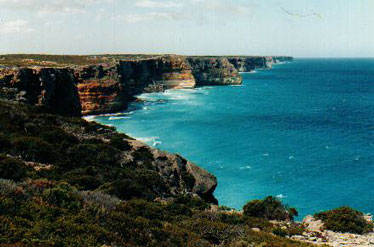
Baxter's
Cliffs
With their duty done, both Eyre and Wylie
marched to the west, departing the grisly murder scene. Eyre's intention
was to travel as quickly as possible in the hope of distancing themselves
from Joey and Yarry.
Events were to prove otherwise, and the
next morning Eyre observed both Joey and Yarry advancing towards him
with firearms at the ready. It was clear to Eyre that the 2 boys were
encouraging Wylie to accompany them. Wylie remained loyal to Eyre
however, and the other two boys were given some stark choices. Yarry
and Joey could either return to Fowlers Bay, or be shot if they continued
to threaten Eyre.
Fortunately there was no bloodshed, and
both Eyre and Wylie headed west. With the advantage of packhorses
Eyre and Wylie soon outpaced Yarry and Joey, and the two boys were
never seen again - by Europeans at any rate. In his journal Eyre expressed
the view that even Yarry and Joey's indigenous hunting skills would
not save them in this remote corner of the outback.
Spirits Rise and the Hope Inspired by a Trickle of Water
By May 1 both Eyre and Wylie had already
travelled for 5 days without discovering fresh water supplies. Hunger,
thirst and exhaustion continued to remain ever pressing problems for
man and beast alike. As the pair walked to the west spirits rose when
Eyre saw some stunted examples of Banksia plants - a species Eyre
well knew to be commonly found within the vicinity of King George's
Sound. Eyre also observed that after 148 miles from the last waterholes,
the never ending cliffs of the western Nullarbor were finally coming
to an end. Within a few miles of the cliffs terminating Eyre had discovered
another set of native wells. Although still 450 miles from King George's
Sound Eyre had good reason to believe that the last of the cruel waterless
stages had been traversed.
By May 8 Eyre was forced to butcher another
of his horses. Eyre's companion Wylie was ecstatic with delight, and
that night he roasted and ate over 20 pounds of meat and entrails.
For Wylie it was a veritable feast. Eyre was always astounded by Wylie's
appetite and was moved to note that under normal circumstances he
was quite capable of eating 9 pounds of meat per day.
For the next ten days Eyre and Wylie skirted
the coastline travelling southwest towards Point Malcolm and Cape
Arid. Just before Point Malcolm, Eyre was excited to note that the
rocky limestone country was changing and giving way to a rough grey
granite. Even better, some mountain ducks were seen aswell as a large
tree trunk found washed up upon the beach. Eyre was firmly convinced
the expedition's fate had taken a turn for the better.
Further proof came with the discovery
of a few drops of water trickling down a granite outcrop. For Eyre,
this was something of a miracle, and he was moved to write .. " ..
this was the only running water we had found since leaving Streaky
Bay, and though it hardly deserved the name, yet it imparted as much
hope, and almost as much satisfaction as if I had found a river."
Wylie Eats A Penguin
By 18-19 May both Eyre and Wylie were
reportedly suffering from a creeping apathy and torpor. Eyre perceived
the condition to be life threatening and the daily chores of life
proved to be a toil, especially digging for water twice a day. Unscheduled
rest stops were frequent and it was difficult maintaining the motivation
to continue. At times such as these, Eyre wrote, "... I could have
sat quietly and contentedly, and let the glass of life glide away
to its last sand."
For a few days Eyre and Wylie were forced
to rest near Point Malcolm. At Point Malcolm the pack horses found
good grazing, whilst Eyre and Wylie lived of the land - procuring
kangaroos, possums, crabs and fish for their daily sustenance. As
ever, Eyre remained fascinated by Wylie's appetite. On one occasion
Eyre noted that Wylie had scoffed down " a pound and a half of horse
flesh, some bread, then the entrails, paunch, liver, tail and hind
legs of a kangaroo, followed by a penguin found dead on the beach."
Eyre Departs Point Malcolm
On 26 May Eyre broke camp with the intention
of proceeding to Lucky Bay. Eyre left Point Malcolm in good spirits,
knowing full well that the naval explorer Matthew Flinders had discovered
abundant water supplies at Lucky Bay. For the very first time Eyre's
expedition had no need to dig for precious water.
Whilst the water may have been abundant,
food supplies continued to remain precarious however, with the expedition's
flour provisions almost exhausted. As a substitute for flour, Eyre
ground up and roasted the roots of flag reeds. In this form the Australian
native flag reed provided a staple food to both Eyre and Wylie.
Rescued By a French Whaling Ship
Near Cape Arid Eyre trekked accross a
headland, traversing granite rises and fording a number of brackish
streams. By 2 June Eyre and Wylie had reached Lucky Bay - completely
unaware that what was about to happen would be beyond their wildest
dreams.
Hardly believing his eyes Eyre spotted
two small sail boats. Eyre and Wylie frantically pushed on attempting
to signal the sail boats. All their attempts failed, but there was
still good reason for hope as Eyre spotted the masts of a ship poking
above an island 6 miles away. The glorious sight of the ship so overwhelmed
Eyre and Wylie that they both skipped about with cries of joy at the
prospect of food.
Salvation was at hand, if only they could
attract the attention of those on board. Eyre then mounted his fastest
horse and galloped 6 miles to a clifftop, from where he could clearly
see a French Whaling vessel moored in the Bay. Eyre and Wylie quickly
made a large fire and successfully attracted the attention of some
French sailors who were cleaning ship's cables. Within minutes Eyre
was on board and enjoying the hospitality of Captain Rossiter, the
English Master of the French Barque "Mississippi"
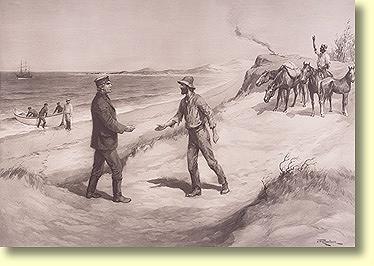
Eyre saved by Captain Rossiter
For 12 days Eyre and Wylie were treated
as privileged guests. In a dazed state Eyre could not help but thank
God " for the inexpressible relief afforded us when so much was needed
and so little expected." Eyre's fate had changed immeasurably. No
longer were he and Wylie subject to starvation, exposure to the elements,
and the intense cold of an Australian winter. Eyre now knew that with
replenished stores, and renewed physical vigour, the goal of King
George's Sound was now assured - even if it was still 300 miles away.
For Wylie, life on board the "Mississippi"
was no less gratifying. Biscuits were in abundance and at first the
French crew were horrified to see Wylie's unbridled appetite in action.
Eyre admired Wylie for making the most of the situation, and later
Wylie's eating habits became a source of amusement to all on board.
The Final Push to King George's Sound
By 14 June Eyre had decided the time was
right to push on to King George's Sound. Captain Rossiter again proved
himself to be a "Good Samaritan of the Sea". Captain Rossiter's generosity
knew no bounds, and Eyre's expedition departed with 40 pounds of flour,
6 pounds of biscuits, 12 pounds of rice, 20 pounds of pork, 2 bottles
of brandy, mountains of tea, sugar and butter, and to cap it all off,
6 bottles of very drinkable French wine. Wylie too was presented with
the fine gift of a pipe, and a large supply of tobacco - of which
he was apparently very fond.
With renewed vigour Eyre and Wylie commenced
their 300 mile trek to the west. Conditions were always difficult
and Eyre and Wylie battled their way through thick scrub interspersed
by stony ridges. For most of the next 10 days Eyre and Wylie had to
bear with constant drenching rain and bitterly cold weather. To add
to their miseries, occasional torrents of rain poured down, and for
many days the ground beneath their feet was covered by sheets of water
- sometimes several inches deep. The contrast with Eyre and Wylie's
experience of the Nullarbor was total. It was impossible to sleep
under such soaking conditions, and at night all that Eyre could do,
was to walk around in order to remain warm.
Travel conditions proved to be energy sapping
both for man and beast alike. For a number of days both Eyre and Wylie
were forced to routinely detour around flooded streams - and when
they weren't doing this, flooded rivers had to be forded. These misfortunes
added many unwanted days and miles to their journey.
By 30 June 1841 Eyre and Wiley were within
sight of the Stirling Ranges. Eyre knew that the destination of King
George's Sound was near at hand. It was only a matter of days at most,
and Eyre reported that Wylie too was very greatly cheered by the prospect
of reaching home. Apparently for the first time in the entire expedition
Wylie really did believe that he would live to see his kinsmen and
tribal lands again. For the next few days the scrub lands gradually
transformed into a finely wooded countryside, and Eyre noted the area
as being eminently suitable for grazing.
As the expedition approached King George's
Sound Wylie assumed the role of a guide. Signs of European settlement
were present, and both Eyre and Wylie were spurred on by the sight
of a horse's hoof marks - moreover, the tracks were only a few days
old. The very next day excitement levels were wracked up a further
notch when Wylie recognised a lake from his past travels.
Emotional Reunions
By 6 July Eyre and Wylie had reached King's
River - a few short miles from King George's Sound. One last obstacle
arose for Eyre and Wylie however, the river was just too high. Eyre
was unwilling to wait for the flood tide to recede and so he and Wylie
abandoned their horses and crossed the river on foot - holding only
the most precious of their possessions above their heads.
Eyre and Wylie then commenced the short
walk to King George's Sound. Along the track Wylie met with one of
his fellow countrymen who greeted him extremely warmly. Apparently
the natives of King George Sound had given up Wylie for dead. Wylie
was expected to have arrived 2 months earlier, and everyone had assumed
the worst and already mourned his loss.
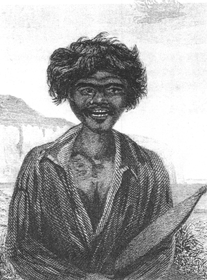
A short time later Eyre, Wylie, and his
friend were standing on a hill, gazing down on the settlement of King
George's Sound. Eyre stood there in torrential rain and wept at the
sight. Wylie's friend then let loose with a series of wild joyous
cries announcing Wylie's unexpected return from the dead. The streets
of King George's Sound were abuzz and Wylie's people rushed to greet
him. Understandably there were many deeply emotional reunions, and
Eyre himself noted, even the strongest ties off affection could not
have produced a more emotional and melting scene.
Eyre and Wylie Attend to Unfinished Business
Eyre's epic journey accross the Great
Austrlaian Bight had now come to an abrupt end. A number of matters
required Eyre's urgent personal attention however, and during the
next week Eyre organized the recovery of his abandoned horses. Both
he and Wylie also presented eye witness accounts to legal authorities
regarding the tragic circumstances of Baxter's death. Surprisingly
Eyre's feelings to Yarry and Joey had now mellowed - believing that
under the same circumstances many Europeans would have behaved no
better.
Farewells and Honours
13 July 1841 saw Eyre bid a final farewell
to Wylie. Sadly, Eyre and Wylie were never to meet again, however
to the end of his days Eyre always held the highest esteem for Wylie.
A measure of this esteem is perhaps reflected in the fact that during
his appointment as the Lieutenant Governor of New Zealand, Eyre sent
Wylie the gift of a double barrelled shot gun. Wylie was apparently
very pleased to receive this gift. On another occasion. Eyre also
successfully interceded on Wylie's behalf when Western Australia's
Colonial government attempted to renege on its commitment to provide
Wylie with a monthly ration of flour and tobacco.
Upon returning to Adelaide Eyre was hailed
as a hero, and given his deep humanity and respect towards aboriginal
people, he was rewarded with a position as The Protector of Aborigines
at Moorundie Reach, near Blanchetown on the River Murray. The Royal
Geographic Society also recognized Edward John Eyre's feats in exploring
remote areas of Southern and Western Australia. During these epic
expeditions Eyre had proven there were few rich grazing lands in the
areas adjacent to the Nullarbor, and that for all intents and purposes,
there was no practical overland stock route between Adelaide and King
George's Sound - or Albany as it is now known. For these trials and
tribulations Eyre was justly rewarded with the Society's Gold Medal.
******
In
the spirit of reconciliation this site is dedicated to the memory
of Edward John Eyre and his companion Wylie.
"If
there is any road not travelled then that is the one I must take."
Edward John Eyre
|





